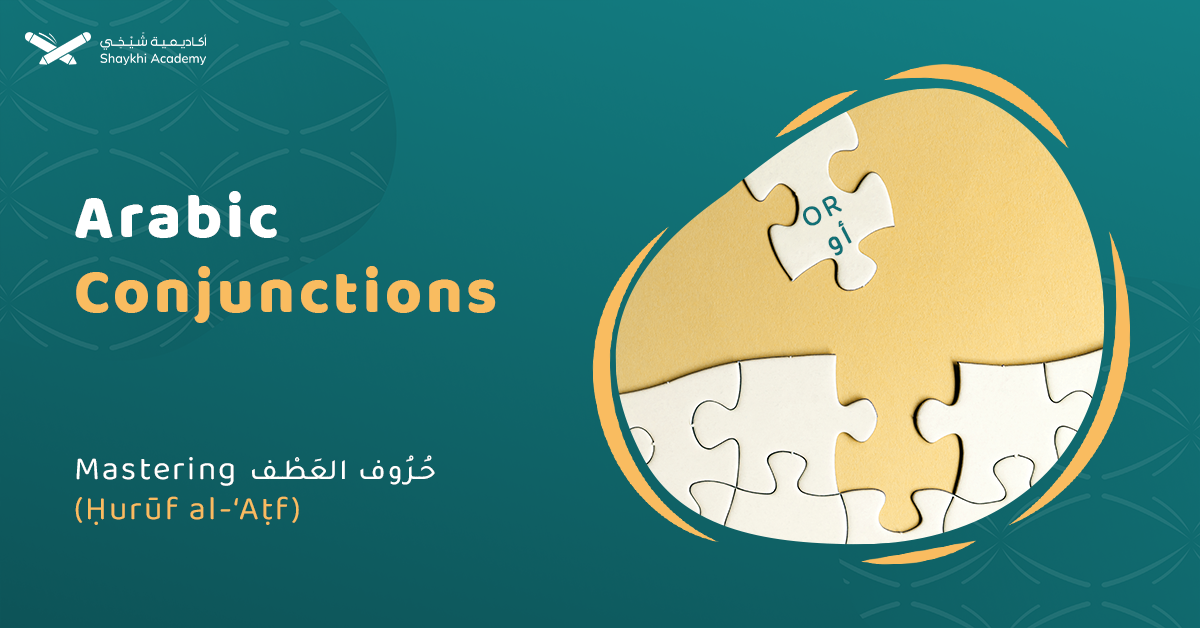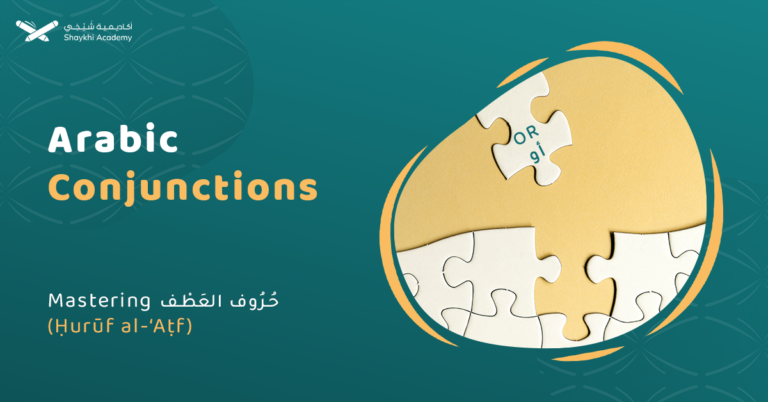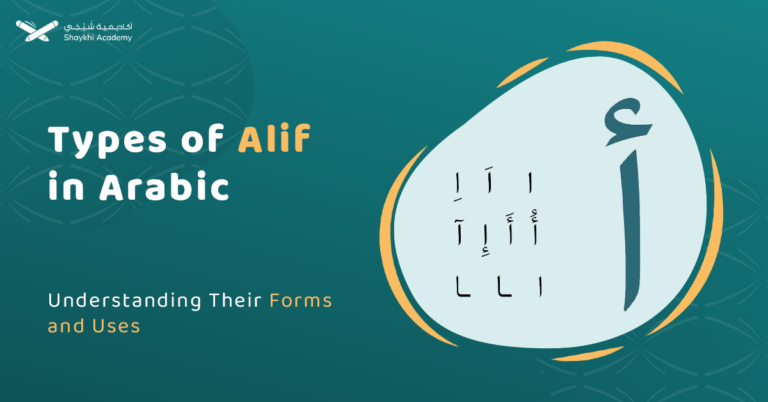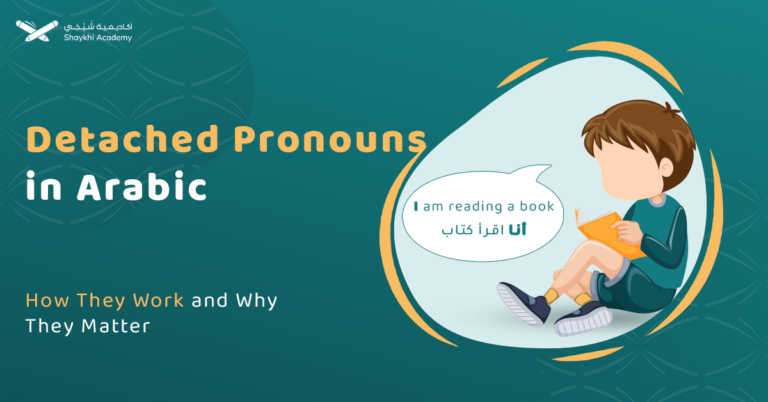Arabic conjunctions (حروف العطف) link words and phrases to form coherent sentences, with types like “و” (and), “لكن” (but), and “فـ” (so) serving specific purposes. Different forms of “و” include linking events, indicating accompaniment, or turning singulars to plurals, each with distinct usage in sentences.
One of the most important grammatical lessons to learn about any language is conjunctions because this is how you learn to link between words or phrases so that you can create coherent paragraphs.
In Arabic as in any language, Arabic conjunctions are important parts of the speech, as they help you connect between words and sentences to build a correct sequence of events.
This article will provide you with information about Arabic conjunction words and their types according to their different usages and meanings of each of them. It will also discuss the different types of “و” in Arabic.
Definition of Arabic Conjunctions (Horoof El-A’tf):
Arabic conjunctions, or “حُرُوف العَطْف” (Horoof El-A’tf), are words used to connect sentences or other words, they also establish relations between phrases like cause and effect.
Conjunctions in Arabic are essential elements that link clauses, and each one of them has a different meaning like “و” (Wa) which means “and”, “لكن” (Laken) which means “But”, and “فـ” (Fa) which means “So”.
Matoof in Arabic Grammar:
Matoof (معطوف) in Arabic grammar is the word or the sentence linked by conjunctions to another word or sentence, which is usually put after the conjunction word.
It’s also grammatically connected to the word or the sentence it’s connected to, which is called “معطوف عليه” (Matoof Alih). Matoof (معطوف) also matches Matoof Alih (معطوف عليه) in number and gender.
What Do Conjunctions in Arabic Do?
In general, the rule for conjunction, or “حرف العطف” (Harf el-ataf), in Arabic is connecting parts of speech or words to produce meaning with a specific sequence.
Some of them may mean “and”, “or”, “but”, “so” or “then”. They are multiple and each one of them has a specific usage in connecting parts of speech.
Arabic Conjunctions List:
There are multiple conjunctions in Arabic, here are some of them:
1. ”و” (Wa)
2. “أم” (Am)
3. “كلما…. كلما” (Kolama…. kolama)
4. “إلا” (Ella)
5. “لو” (Law)
6. “لأن” (La’ann)
7. “متى” (Mata)
8. “بل” (Bal)
9. “كذلك” (Kazalek)
Different Types of “و” in Arabic:
The letter “و” is more than just an alphabetical letter, as it can be used in different grammatical rules, and its meaning differs according to its usage.
1. “و” of Accompaniment:
“و” of accompaniment, or “واو المعية” (Waw El-Ma’aeya), links between two events and means that they are happening alongside each other.
For example, “شربت الشاي وقرأت الكتاب” means “I drank tea while reading the book” and is pronounced as “Sharebt al-shay wa qara’t al-ketab”.
For example, “جاء أحمد ومحمد” means “Ahmed came with Mohammed” and is pronounced as “Ja’a Ahmed wa Mohammed”.
2. “و” As A Conjunction (Harf El-Ataf):
“و” as a conjunction, or “حرف العطف” (Harf El-Ataf), means “And” and is used to link between elements of equal essentiality.
For example, “أحب القراءة والسباحة” means “I like reading and swimming” and is pronounced as “Auheb al-qira’ah wa al-sebaha”.
3. “و” Used to Describe States:
“و” used to describe states, or “واو الحال” (Waw El-Hal), is used to describe the condition of the subject while doing an action.
For example, “جاءت الفتاة وهي تبكي” means “The girl came crying” and is pronounced as “Ja’at al-fatah wa hya tabky”.
4. “و” Used for Turning Singular into Plural:
“و” used for turning the singular into plural, or “واو الجماعة” (Waw El-Jama’ah), is used with nouns or verbs to transform them into plural form to refer to a group. Plural nouns with (Waw el-jama’ah) refer to masculine plurals.
| Examples | Singular | Plural |
| Nouns | “هو جيد” (Hwa jayeed) | “هم جيدون” (Hm jayeedun) |
| Translation | He is good | They are good |
| Verbs | “يكتب” (Yaktub) | “يكتبون” (Yaktubun) |
| Translation | He writes | They write “for plural masculine” |
Types of Conjunctions in Arabic:
Conjunctions in Arabic are divided into multiple types according to the relation or connection they create between elements, words, or phrases.
We will discuss their different types in the following paragraphs, with varying examples of using each conjunction in Arabic grammar sentences.
1. Subordinating Conjunctions in Arabic:
Subordinating conjunctions in Arabic are words used to link two dependent unequal events while one of them depends on the other, which is considered the main one, to produce meaning.
A) “لذلك” (Lezalek):
“لذلك” (Lezalek), which means “So”, is used to link two phrases, one of them is the consequence of the other.
For example, “الجو بارد لذلك سأبقى في المنزل” means “The weather is cold, so I am going to stay home” and is pronounced as “Al-jaw bared lezalek sa’abqa fi el-manzel”.
B) “عندما” (E’ndama):
“عندما” (E’ndama), which means “While”, is used to link two clauses happening in the same tense either in the present or in the past, but one precedes the other.
For example, “عندما كنت نائمًا رن الهاتف” means “While I was sleeping, the phone rang” and is pronounced as “E’ndama kont nae’man ranna al-hatef”.
Another example, “عندما تكمل واجبك المنزلي يمكنك اللعب” means “While you finish your homework, you can play” and is pronounced as “E’ndama tokmel wajebak al-manzeli youmkenak al-la’eb”.
C) “لو” (Law):
“لو” (Law), which means “If”, is used to connect two clauses when one clause is considered as a condition for the main one to happen. The main clause should be in the past tense, and the other one may be in the present or the past.
You may add the letter “لـ” to the verb of the main clause for confirmation or to say that for sure it would have happened.
For example, “لو ذاكرت جيدًا لنجحت” means “If you studied well, you could have succeeded” and is pronounced as “Law zakart jayeedan lanajaht”.
D) “حينما” (Hinama):
“حينما” (Hinama), which means “When”, is used to link two clauses when they are both happening at the same time, which may be in the present, the past, or the future.
For example in the future, “سأتصل بك حينما أصل إلى المنزل” means “I will call you when I get home” and is pronounced as “Sa’atasel bk hinama asel ela al-manzel”.
Another example in the past, “حينما كنت صغيرًا كنت أذهب للسباحة” means “When I was younger, I used to go swimming” and is pronounced as “Hinama kont saghiran kont azhab le’lsebaha”.
E) “كلما” (Kollama):
“كلما” (Kollama), which means “Whenever”, is used to link two clauses with past tense verbs, and refers to the repetition of the second clause whenever the first one happens.
For example, “كلما ذهبت إلى المنزل شعرت بالأمان” means “Whenever I went home, I felt safe” and is pronounced as “Kollama zahabtu ela el-manzel sha’artu bel’aman”.
F) “إن” (Enn):
“إن” (Enn), which means “If”, is used in a conditional sentence to link two clauses when the main one is considered as a condition for the other to happen.
For example, “إن تذاكر بجد تنجح” means “If you study hard, you will succeed” and is pronounced as “Enn tuzaker beged tangah”.
G) “لأن” (La’ann):
“لأن” (La’anna), which means “Because”, is used to link two phrases, one of them is the reason for the other.
For example, “سأبقى في المنزل لأن الجو ممطر” means “I will stay at home because it’s rainy” and is pronounced as “Sa’abqa fi el-manzel La’anna al-jaw momter”.
H) “متى” (Mata):
“متى” (Mata), which means “When”, is used to link two clauses when they are both happening in the same tense and it must be in the present tense, but one clause cut the other.
For example in the future, “متى أصل إلى العمل أشرب الشاي” means “When I arrive at work, I drink tea” and is pronounced as “Mata asel ela ala’mal asharabu el-shay”.
2. Coordinating Conjunctions in Arabic:
Coordinating conjunctions in Arabic are words used to link words or sentences which are equally important.
A) ”و” (Wa):
”و” (Wa), which means “And”, is used to link things, names, or events that are happening alongside each other.
For example, “حضر أحمد ومحمد” means “Ahmed and Mohammed came” and is pronounced as “Hadara Ahmed wa Mohammed”.
Another example, “الكرسي والطاولة في الغرفة” means “The chair and the table are in the room” and is pronounced as “Al-korsi wa al-tawelah fi al-ghorfa”
B) “حتى” (Hatta):
”حتى” (Hatta), which means “Even”, is used to link things or names to provide the meaning of praise or abasement.
For example, “نجح الجميع حتى عمر” means “Everyone succeeded even Omar” and is pronounced as “Nagaha al-jame’e hatta Omar” giving the meaning that even Omar who is not the best has succeeded.
Another example, “أخفق الجميع حتى أحمد” means “Everyone failed even Ahmed” and is pronounced as “Akh’faq al-jame’e hatta Ahmed” giving the meaning that even Ahmed who is the best has failed.
C) “لكن” (Laken):
“لكن” (Laken), which means “But”, is used to link things or names to negate something about the element put before it and prove it about the element put after it. So, it’s used with negative sentences.
For example, “ما حضر أحمد لكن محمد” means “Ahmed didn’t come but Mohammed did” and is pronounced as “Ma hadara Ahmed laken Mohammed”.
D) “بل” (Bal):
“بل” (Bal), which means “Rather”, is used to link things or names to negate something about the element put before it and prove it about the element put after it, too. So, it looks like the previous conjunction but can be used with negative and affirmative sentences.
For example, “ذهبت إلى المطعم بل إلى النادي” means “I went to the restaurant, rather the club” and is pronounced as “Zahabtu ela al-mata’am bal ela al-nady”.
For example, “ما قرأت الكتاب بل القصة” means “I didn’t read the book, rather the novel” and is pronounced as “Ma qara’t al-ketab bal al-qessa”.
E) “فـ” (Fa):
“فـ” (Fa), which means “Then” or “So”, is used to link things, names, or events that are happening one after the other or to express an event as a consequence of the other.
For example, “حضر أحمد فمحمد” means “Ahmed came then Mohammed” and is pronounced as “Hadara Ahmed fa Mohammed”.
Another example, “درست جيدًا فنجحت” means “I studied well, so I passed” and is pronounced as “Darastu jayeedan fa nagaht”
F) “أم” (Am):
“أم” (Am), which means “Or”, is used to link things or names to choose between them. So, it’s used in yes-no questions in Arabic which start with “هل”(Hal) or “أ” (A).
For example, “هل تحب القهوة أم الشاي؟” means “Do you like coffee or tea?” and is pronounced as “Hal toheb al-qahwa am al-shay?”.
Another example, “أتحب القراءة أم الكتابة؟” means “Do you like reading or writing?” and is pronounced as “Hal toheb al-qera’ah am al-ketabah?”.
G) “ثم” (Thumma):
“ثم” (Thumma), which means “then later”, is used to link things, names, or events that happened subsequently or one after the other.
For example, “ذهبت إلى النادي ثم إلى المنزل” means “I went to the club, then later I went home” and is pronounced as “Zahabtu Ela al-nady thumma ela al-manzel”.
For example, “قابلت أحمد ثم محمد” means “I met Ahmed then later Mohammed” and is pronounced as “Qabaltu Ahmed thumma Mohammed”.
You can get more information by joining the Classical Arabic Course from Shaykhi Academy.
Or you can get more detailed grammatical information by joining the Arabic Grammar Course.

Book your free trial now!
3. Correlative Conjunctions in Arabic:
Correlative conjunctions in Arabic are words that are used as pairs and work together to link two elements or phrases of equal importance.
A) “إما…. أو” (Emma…. aw):
“إما…. أو” (Emma…. aw), which means “Either…. Or”, is used to provide a choice between two equally essential elements.
For example, “إما تشرب العصير أو القهوة” means “Either you drink juice or coffee” and is pronounced as “Emma tashrub Al-a’sir aw al-qahwa”.
B) “لا…. ولا” (La…. wa-la):
“لا…. ولا” (La…. wa-la), which means “Neither…. Nor”, is used to negate something about the two elements it is linking.
For example, “لا أحب القهوة ولا العصير” means “I like neither coffee nor juice” and is pronounced as “La auheb al-qahwa wa-la al-a’sir”.
C) “كلما…. كلما” (Kolama…. kolama):
“كلما…. كلما” (Kolama…. kolama), which means “The more…. The more”, represents a cause-effect relation between the elements it links between to tell that increasing the first event will increase the second one.
For example, “كلما شربت ماء أكثر، كلما أصبحت أكثر صحة” means “The more water you drink, the healthier you become” and is pronounced as “Kolama sharebt ma’an akthar, kolama asbaht akthar sehatan”.
D) “كما…. كذلك” (Kama…. kazalek):
“كما…. كذلك” (Kama…. kazalek), which means “Just as…. so too”, is used to show that the two elements it links between are of equal importance.
For example, “كما تحب الرسم، كذلك تحب القراءة” means “Just as she likes drawing, so too she likes reading” and is pronounced as “Kama toheb al-rasm, kazalek tohen al-qera’ah”.
4. Conjunctive Adverbs in Arabic:
Conjunctive adverbs in Arabic are words used to connect actions or sentences indicating their relationship whether it’s conditional, causative, or result. But the two sentences they link between are independent which means that each one can stand alone and provide meaning.
- “لذلك” (Lezalek) which means “So” and was discussed before.
- “لكن” (Laken) which means “But” and was discussed before.
- “إلا” (Ella): “إلا”(Ella), which means “Except”, is used to exclude an element. For example, “حضر الجميع، إلا مريم” means “Everyone attended, except Mariam” and is pronounced as “Hadar al-jame’e, ella Mariam”.
- “كذلك” (Kazalek): “كذلك” (Kazalek), which means “Likewise”, is used to add more information. For example, “أحب السباحة وكذلك الجري” means “I like swimming likewise running” and is pronounced as “Auheb al-sebaha wa kazalek al-jarey”.
Arabic Conjunctions Worksheet:
Here are some exercises to evaluate whether you understood the previous information provided, and also to apply the previous rules:
1. Complete the sentence with the correct conjunction:
- الجو ممطر ……….. سأبقى في المنزل.
(Choose the appropriate conjunction to fill in the blank to make the sentence meaningful.)
2. Choose two different conjunctions to complete the sentence with two distinct meanings:
- حضرت مريم …… فريدة.
(Select two conjunctions that change the meaning of the sentence.)
3. Translate the sentence “The more you learn, the smarter you get” into Arabic, using the correct conjunction.
4. Translate the sentence “When I was a kid, I used to go to the club” into Arabic, using the proper conjunction.
Learn More about Conjunction with The Arabic Grammar Course from Shaykhi Academy:
One of the most interesting experiences you will have in learning Arabic conjunctions or Arabic grammatical rules in general is the Arabic Grammar Course from Shaykhi Academy.

Some of the skills you are going to gain from this course are learning Arabic grammar and its terms, defining different parts of Arabic sentences to understand their structure, and knowing how to use the suitable verb for each noun.
This course is provided by friendly native supportive tutors who will help you learn better and faster and will also provide you with continuous feedback to evaluate your progress.
This course has affordable cost in comparison to the quality of data provided. It also has multiple plans according to your level, your suitable curriculum, and also according to the budget you can afford.
Book your free trial now!
Why Shaykhi Academy?
- Expert Native Tutors: Learn from highly qualified native Arabic speakers.
- Flexible Scheduling: Tailor your classes to fit your busy life.
- Affordable Learning: Access top-quality education at a price that suits you.
- Global Access: Study from anywhere in the world.
Explore Our Arabic Courses:
- Noorani Qaida: Build a strong foundation in Quranic Arabic.
- Comprehensive Arabic Courses: Master the Arabic language, from beginner to advanced levels.
- Fusha Arabic Classes: Delve into Modern Standard Arabic, the key to understanding literature, media, and formal communication across the Arab world.
- Quranic Arabic Course: Enhance your connection with the Quran by learning the language in which it was revealed.
Start Your Arabic Journey Today! Whether you’re just starting or looking to deepen your knowledge, Shaykhi Academy is here to support your journey. Book your free trial now and begin your path to Arabic mastery!
Conclusion:
Arabic conjunctions are words used to link between other elements, words, sentences, clauses, or events to provide meaning according to the conjunction used.
That meaning may be cause-effect relation, result relation, comparison, choices, a specific sequence of events or just expressing equal importance of the elements linked.
In Arabic, The letter “و” is more than just an alphabetical letter, as it has other usages in Arabic grammatical rules, which affects its meaning. As a conjunction, it means “And”, but in other uses, it has a different meaning.
If you need more information, Contact us for help!















































